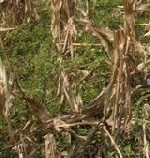The shortage of desmodium seeds is an important limiting factor for much wider dissemination of the 'Push-Pull' technology in sub-Saharan Africa (SSA). Although technology and methods for the production of seeds and development of local markets are now developed in collaboration with farmers, local seed companies and stockists, availability of large quantities of good quality seeds is essential for the planned full scale expansion. Recently an external review of icipe programmes concluded that this problem should be given high priority as it is a major cause of the limited spread of the 'Push-Pull' system. According to the reviewer efforts to select high seed yielding varieties should also be undertaken.
Due to high demand of the 'Push-Pull' technology and unavailability of desmodium seed in market, two informal pathways have emerged during last three years:
1) Vegetative propagation among small holder farmers.
2) Community-based seed production initiatives.
Although, vegetative mechanism could evolve into an important mechanism for local diffusion of the 'Push-Pull' technologies among resource-limited farming communities, large quantities of seed is still required, through both formal and informal systems, for massive expansion of the technology in SSA. We are presently analysing and comparing the relative merits of formal and informal pathways in stimulating autonomous diffusion of the Push-Pull technology.


 Research Partners
Research Partners